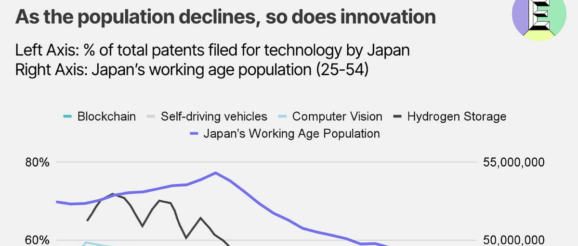 Babies and innovation; what tech does to morals; India’s new curriculum; brain wrinkles, trends, Ozempic++ #425
Babies and innovation; what tech does to morals; India’s new curriculum; brain wrinkles, trends, Ozempic++ #425

Hi, I’m Azeem Azhar. As a global expert on exponential technologies, I advise governments, some of the world’s largest firms, and investors on how to make sense of our exponential future. Every Sunday, I share my view on developments that I think you should know about in this newsletter.
In today’s edition:
-
Population trends & innovation,
-
How tech shapes moral values,
-
Better chips.
Sunday chart: Innovation’s age-old challenge
Changes in the global population have been a major topic this year, with a focus on how ageing populations strain social security and healthcare systems. This problem will be widespread in developed economies, with none of the 15 largest economies in the world having fertility rates that exceed the replacement rate of 2.1.
As Mike Bird observes in The Economist, it’s this younger demographic that is disproportionately responsible for driving the engine of disruptive innovation and entrepreneurship — the very lifelines of any thriving economy, the key to raising productivity. The situation gets grimmer when we consider that global population decline might be occurring at a rate and scale far beyond our initial estimates.
Attempts to increase birth rates in countries in or approaching demographic decline have a mixed track, largely poor track record, with Sweden and France being two moderate successes. Policies that can reverse personal choices seem unlikely. For economies, this may mean increasing investment in human capital (through education), seeking to use AI to meet labour shortages or even rethinking immigration policies. Science may yet afford a potentially dystopian route: a couple of years ago, Chinese scientists successfully created viable offspring from single, unfertilized mouse eggs.
Key reads
Bye-bye science: India has recently excised evolution, the periodic table, and energy sources, from its school curriculum — setting aside learning that lays the groundwork for scientific comprehension and foster critical thinking. Other topics that have been removed include analysis of democracy, pluralism and political dissent. If this is rolled out across the country, it’s terrible news for India. Investments in human capital – education – are key drivers of shared prosperity in times of technological change. Freedom to think, whether through the scientific method or simply being critical of the system, is an essential enabler of research, entrepreneurship and wealth.
How tech shapes morals: I’ve followed the work of philosopher John Danaher for several years (see EV#104, #237, #329). He has a new paper asking how exactly do technologies change moral values and behaviours? John has a lovely taxonomy for change: creating new options; changing the costs and benefits of decisions; enabling new types of relationships; altering expectations of existing relationships; changing power within relationships and, quite key for me, providing new information or models that help us shape our moral perception. These modalities operate at various societal scales and have interrelated effects, producing complex moral transformations. Clarifying these processes can help us better figure out how technology affects what we believe and care about. Worth a read.
Less Moore Miniaturisation has been the rallying cry of the semiconductor industry. Cramming more transistors onto silicon. Moore’s Law’s death has been called more more than a decade but the physics and economics are getting harder to stomach. Great review by Tim Bradshaw. I view shrinking as just one way to eke out every more computational performance per buck. There are others: like new chip architectures and topologies (like 3-d chips) or more specialist chips, like GPUs, for particular tasks that will drive continued progress.
Weekly commentary
My take on the hoopla around existential risks from AI.
Market data
Fidelity, which owns a stake in Twitter, has decreased its valuation to 33% of what Musk purchased it for ($44 billion).
44.5% of US workers are already using ChatGPT in the workplace, according to Deutsche Bank (33.1% in the UK).
The Nasdaq 100 Index, compared to the Russell 2000 Index, is at its highest level since the dot-com era over 20 years ago, driven by the strong performance of mega-cap technology and internet stocks. (The Russell 2000 tracks smaller growth stocks but doesn’t have a particularly strong technology leaning.)
The cost estimates for the NuScale small modular nuclear reactor have soared by 124%, now standing at $130 per MWh, up from the original estimate of $58
South Korea’s semiconductor inventory surged by 83% in April, reaching its highest levels since 2016, indicating a slowdown in tech product demand.
The IEA has revised its 2023 forecast for new renewable capacity upwards by 24%. This is a six-month-old forecast. I’m delighted to see that in these rapidly changing times, the IEA remains a bastion of stability – in continuously lowballing renewable forecasts.
Short morsels to appear smart at dinner parties







End note
Succession, eh? Managed to see the whole thing in the end. Yes, I thought it was the best thing I’ve seen on telly.
Happy to take recommendations for future viewing below!
Cheers,
A
What you’re up to — community updates
-
The Guardian published a profile on EV member Rumman Chowdhury.
Share your updates with EV readers by telling us what you’re up to here.
